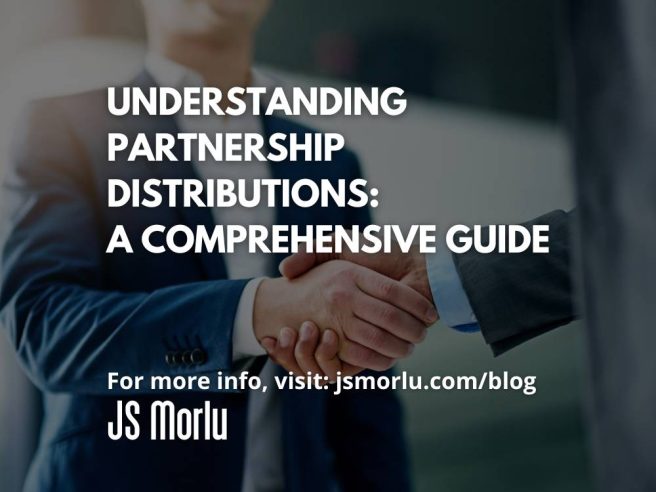By: John S. Morlu II, CPA
Partnership distributions are an essential yet complex component of partnership taxation. These distributions, which refer to the transfer of cash or property from a partnership to its partners, must be carefully managed to avoid unexpected tax consequences. This guide simplifies the subject, focusing on nonliquidating cash distributions—those that do not dissolve the partnership—and their effects on a partner’s tax basis and potential taxable gains.

What Are Partnership Distributions?
Partnership distributions provide partners with a way to access the business’s profits or assets. Unlike S corporations, which are bound by rules requiring pro rata distributions (equal distributions based on ownership percentages), partnerships have significant flexibility.
For example, a partnership can distribute cash or property to one partner while not distributing to another. This flexibility allows partnerships to meet individual partners’ financial needs or strategic goals without violating tax rules. However, this benefit comes with the responsibility of carefully tracking each partner’s tax basis to determine whether distributions result in taxable gains.
Key Tax Rules for Partnership Distributions
1. Nonrecognition of Gain for Property Distributions:
When a partnership distributes property (other than cash), the recipient partner does not recognize a gain or loss, regardless of the property’s value relative to their basis in the partnership. This rule provides significant tax advantages for partnerships by allowing the transfer of property without immediate tax implications.
2. Cash Distributions and Taxable Gain:
Cash distributions, however, can lead to taxable gains if the amount distributed exceeds a partner’s outside basis. In such cases, the excess amount is treated as a capital gain, subject to taxation under Section 731(a)(1) of the Internal Revenue Code.
What Is Partner Basis, and Why Is It Important?
A partner’s tax basis represents their financial stake in the partnership. It determines whether distributions are taxable and serves as a critical measure for tracking a partner’s share of the partnership’s income, losses, and liabilities.
Types of Basis
- Inside Basis: The partnership’s basis in its assets, which reflects the tax value of the assets owned by the partnership.
- Outside Basis: The partner’s tax basis in their partnership interest, used to calculate gain or loss upon distributions or the sale of the partnership interest.
While inside basis can fall below zero without immediate tax consequences, outside basis cannot. If a partner’s outside basis drops below zero due to distributions, the partner must recognize a taxable gain to restore the basis to zero.
How to Calculate Basis
A partner’s basis is adjusted annually to reflect the partnership’s income, losses, contributions, distributions, and other factors. Under Section 705 of the Internal Revenue Code, the formula for calculating a partner’s basis is:
Beginning Basis
- Taxable income from the partnership (as per Section 703(a))
- Tax-exempt income
- Excess of depletion deductions over property basis
- Distributions
- Losses of the partnership
- Nondeductible expenses
= Ending Basis
For simplicity, this formula can be condensed to:
Beginning Basis + Increases (Income, Gains, Contributions) – Distributions – Decreases (Losses, Nondeductible Expenses) = Ending Basis
Example: Calculating Basis in a Real-World Scenario
Let’s explore how these rules apply in a practical example:
Scenario
- A and B share equally in the profits and losses of AB Partnership.
- On January 1, A’s basis in the partnership was $30,000, and B’s basis was $5,000.
- On July 1, each partner received a $20,000 cash distribution.
- Partnership taxable income for the year was $24,000, allocated equally between A and B.
- No additional contributions or changes to partnership liabilities occurred during the year.
Calculation
| Item | A’s Basis | B’s Basis |
| Basis at January 1 | $30,000 | $5,000 |
| Add: Share of income | +$12,000 | +$12,000 |
| Subtract: Cash distribution | -$20,000 | -$20,000 |
| Ending Basis | $22,000 | ($3,000) |
In this example:
- A’s basis reduces to $22,000 after the distribution and income allocation.
- B’s basis drops below zero to ($3,000). Since a partner’s outside basis cannot be negative, B must recognize a $3,000 capital gain. This gain restores B’s basis to zero.
Unique Aspects of Partnership Distributions
1. Flexibility in Distributions:
Unlike S corporations, partnerships are not required to distribute profits evenly. A partnership can allocate cash or property to one partner without affecting others, allowing for tailored financial strategies.
2. Debt and Basis Adjustments:
A significant difference between partnerships and S corporations is how debt affects basis:
- S Corporations: Shareholders’ basis is not increased by corporate debt.
- Partnerships: A partner’s share of partnership liabilities increases their outside basis, which can help avoid gains on distributions.
3. Tax Treatment of Gains:
While property distributions are generally not taxable, cash distributions exceeding a partner’s outside basis result in taxable gains, providing a key area to monitor when planning distributions.
Case Study: The Advantage of Partnership Rules
Consider a partnership with three partners: X, Y, and Z. The partnership earns $300,000 in profits and distributes $150,000 to X, while Y and Z receive nothing. Such flexibility would not be permissible in an S corporation, as it would violate pro rata distribution requirements. However, partnerships allow this without any structural issues, provided each partner’s tax basis is carefully tracked to avoid negative consequences.
Final Thoughts: Managing Partnership Distributions
Partnership distributions provide significant flexibility and tax advantages compared to other business structures. However, their complexity requires careful planning to:
- Avoid taxable gains due to excessive cash distributions.
- Accurately track each partner’s basis to ensure compliance with tax rules.
- Maximize the benefits of partnership flexibility for individual partners’ financial needs.
Partnerships offer a unique blend of adaptability and opportunity, but navigating their rules effectively often requires the guidance of a tax professional. By understanding these key principles, partners can better manage distributions and achieve their business and financial goals.
Author: John S. Morlu II, CPA
John Morlu II, CPA, is the CEO and Chief Strategist of JS Morlu, a globally acclaimed public accounting and management consulting powerhouse. With his visionary leadership, JS Morlu has redefined industries, pioneering cutting-edge technologies across B2B, B2C, P2P, and B2G landscapes.
The firm’s groundbreaking innovations include:
• ReckSoft (www.ReckSoft.com): AI-driven reconciliation software revolutionizing financial accuracy and efficiency.
• FinovatePro (www.FinovatePro.com): Advanced cloud accounting solutions empowering businesses to thrive in the digital age.
• Fixaars (www.fixaars.com): A global handyman platform reshaping service delivery and setting new benchmarks in convenience and reliability.
Under his strategic vision, JS Morlu continues to set the gold standard for technological excellence, efficiency, and transformative solutions.
JS Morlu LLC is a top-tier accounting firm based in Woodbridge, Virginia, with a team of highly experienced and qualified CPAs and business advisors. We are dedicated to providing comprehensive accounting, tax, and business advisory services to clients throughout the Washington, D.C. Metro Area and the surrounding regions. With over a decade of experience, we have cultivated a deep understanding of our clients’ needs and aspirations. We recognize that our clients seek more than just value-added accounting services; they seek a trusted partner who can guide them towards achieving their business goals and personal financial well-being.
Talk to us || What our clients says about us





